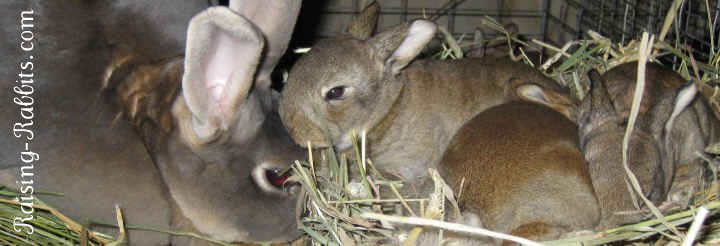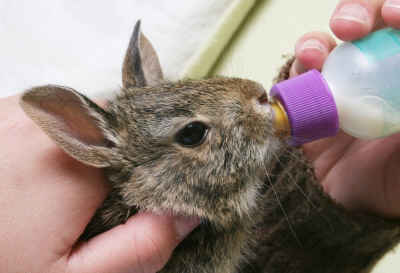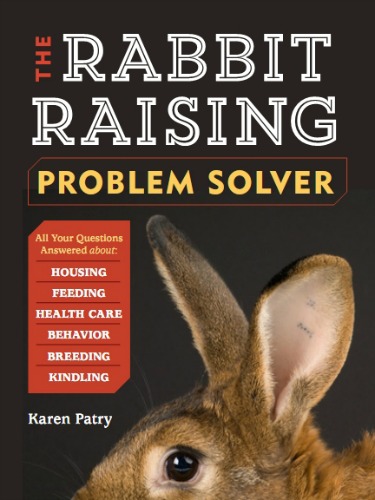What to Feed Bunnies 17 Days Old
Feeding Baby Rabbits
Feeding baby rabbits falls mostly to the mother rabbit for the first 3 weeks of the bunny's life. Between 3 weeks and around 6 weeks old, the baby rabbits need less and less of mom, and more and more pellets and hay.
At the point they no longer "need" the mother for food, they are said to be weaned. This physiological point arrives almost precisely at 4 weeks of age, at least in regards to the operative word "need." This means that a kit orphaned for some reason at 3.5 - 4 weeks old can go straight to solids, and will not need supplemental milk unless it happens to also be malnourished.
In our domestic rabbits, however, the doe permits her kits to keep right on nursing, simply because she can physically afford to do so. The typical litter of bunnies in your home or hutch can be 6-7 weeks of age, possibly older, by the time their mums forbid any more nursing.
See our Raising Baby Rabbits page for more detail on the normal care of bunnies from 2 weeks of age and older, including the processes of weaning the litter.
What do you do if something catastrophic happens to the doe?
Every once in a while tragedy strikes. The doe could develop young doe syndrome. You'd find her suddenly dead in her cage, with her kits being just a week or 10 days old. Or, the doe could develop mastitis, refuse to nurse the kits because of the pain, or herself die from bacterial toxins.
Whatever the disaster, feeding baby rabbits now falls to the rabbit owner.
What you do will likely depend on how old the kits are. Obviously, the older, the better the survival rate.
Can you foster the baby rabbits to another doe?
Between the age of 0 to about a week, fostering is fairly easy, especially if the kits are within a couple days of the age of the foster-mother's kits. Just slip the babies into the new doe's nest. Do it in the morning, and rub their little bodies gently with the new doe's fur in order to transfer her smell to them.
As you replace the nestbox, give the new doe a generous helping of calf manna, whole oats, or a favorite treat, in order to distract her. She'll think everything is fine, and by evening, all the kits should smell like they belong in the nest. If you're still nervous about the doe, just leave the nestbox outside the nest all day, and then put it back in with the doe about suppertime.
The foster doe will do a much better job at feeding baby rabbits than you could, if you don't overwhelm the new doe with a dozen bunnies. How many kits you give her may depend on her ability to make the additional milk. Adding a source of fats, like whole oats or black oil sunflower seeds, will definitely help her augment her milk supply.
Rabbit Condition Enhancers: BOSS, Whole Oats
 These very healthy 2 1/2 week old baby rex rabbits still rely nearly entirely on the doe's milk.
These very healthy 2 1/2 week old baby rex rabbits still rely nearly entirely on the doe's milk.
No does to foster the kits to?
You can attempt bottlefeeding. Here's some tips and techniques, depending on the age of the orphaned kits.
But first, a sober head's up: Without careful attention to the bunnies' dietary needs, the s urvival rate for bottle-fed infant bunnies can be as low as 0 - 10%, especially if the babies are orphaned before their eyes open. That means 9 out of 10 (or worse) often don't survive. There are a number of reasons bunnies fail to survive without their mums. Here are the most common reasons:
- Incorrect formula
- Milk gets into the lungs and causes pneumonia
- They don't get enough antibodies from their mother and die from infection
- The kits get a fatal diarrhea. Their intestinal bacteria population is quite sensitive. Until they start eating solids, their guts are actually sterile. But the formula is not sterile, nor should it be. So if you start introducing unnatural bacteria to the guts too soon, before the normal bacteria have started populating the gut, the kit gets severe enterotoxemia and dies. This is probably the most frequent cause of death in rabbits orphaned in their first week of life.
- The bunnies don't get enough nutrition, or too much at once.
- The bunny fails to urinate or defecate with each feeding, and the bladder over-fills and bursts. The doe licks her kits' bottoms as they nurse, so the rabbit-raiser needs to not overlook this little detail of rabbit-motherhood. You can use a wet finger, or a soft moistened tissue. Make motions as the doe would, like you're cleaning the bunny's privates. It might take a few minutes, at least at first, until you get the desired response. I'll tell you this - that little stream of urine can shoot out a good four feet!
Proven Guidelines for Feeding
Baby Rabbits

Lou Rea Kenyon, a registered nurse and a licensed wildlife rehabilitation expert, has successfully saved bunny-lives for over 17 years. She is the owner of Nutkin's Nest Wildlife Rehabilitation Center.
This is where we would send you directly to her wild-cottontail-feeding protocols, however her website has disappeared from the web.
With her permission however, we summarized Ms. Kenyon's instructions on our Feeding Wild Rabbits page, because her instructions for feeding baby rabbits work for both cottontails and orphan domestic rabbit bunnies.
Rabbit Milk Replacement Suggestions
We recommend Goat's Milk Esbilac, or Esbilac Milk Replacer for Puppies. Whatever formula you use to hand-feed bunnies, it will still need the addition of fat. The easiest way to do this is to use heavy cream.
Bene-Bac (or healthy cecotropes) will be another essential ingredient of the milk formula in order to prevent fatal diarrhea.
- Bene-Bac in Bulk
See Feeding Wild Rabbits for the formulas and details , including some suggestions should you have been surprised by the sudden death of a doe, and not have on hand any formula.
Good luck with feeding baby rabbits!
Feeding baby rabbits orphaned at
3 or 3.5 weeks old
By three weeks old, baby rabbits are already nibbling pellets and hay, but they still need mother's milk. They may also still be at risk for life-threatening bunny diarrhea. Nevertheless, their survival rate improves dramatically by 3.5 weeks old, even on just excellent rabbit pellets and water.
This Bunny Food is Currently the Best I Have Found:
- Besides providing pellets and alfalfa hay, some very dry (non-moldy) bread soaked with raw, unpasteurized cow's or goat's milk might be a good milk substitute for feeding baby rabbits. (Raw milk available from some dairy farms and very possibly at a nearby health food store, depending on the state you live in). Or, soak the dry bread in Kitten Milk Replacer (KMR). Offer this to the kits.
- If you can get them to take it, great. Otherwise, supplement with bottle feedings once a day for a week or so.
- Some young bunnies can learn to drink formula from a bowl. Don't leave a bowl of bunny-milk in the cage for more than 1/2 hour, lest they walk in it and contaminate it with droppings.
- By the time they're 4 to 4 1/2 weeks old, they will be fine on high-protein pellets (17-18% protein), an oil supplement (whole oats, black oil sunflower seeds, or real wheat germ oil), and alfalfa or grass hay. (Alfalfa hay is good for these youngsters, being high in protein and suitable for their rapid-growth needs.)
- Always keep an eye on their rumps, to ensure they aren't developing bunny-diarrhea. Without mama's milk, the chance for disrupted gut bacteria is great. At the first sign, feed the bunny a slurry of formula mixed with 1-2 healthy cecotrope 'packets' (a single entire grape-like cluster of cecotrope). At the same time, replace all feeds with grass hay, till their rumps clear up, hopefully 24 - 72 hours. Then reintroduce their regular rabbit diet.
Click here for lots more on feeding orphan baby rabbits and cottontails
- Home ›
- Feeding Rabbits ›
- Feeding Baby Rabbits
dunaganmanothaver.blogspot.com
Source: https://www.raising-rabbits.com/feeding-baby-rabbits.html


0 Response to "What to Feed Bunnies 17 Days Old"
Post a Comment